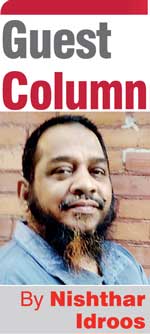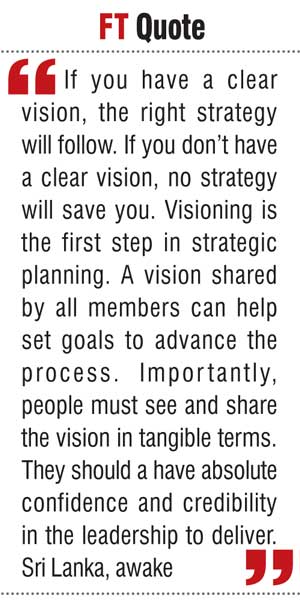Monday Dec 22, 2025
Monday Dec 22, 2025
Friday, 15 January 2016 00:00 - - {{hitsCtrl.values.hits}}
Singapore Airlines is a top luxury airline in the aviation industry. In 2013, 54.1 million passengers went through Changi Airport, the most in its 33-year history. Compare this with SriLankan Airlines, Mihin Air, Hambantota Port and Airport. Where is the vision? Where is the strategy? Where is the collective commitment?
“We had a deep sense of mission to establish a clean and effective government. When we took the oath of office at the ceremony in the city council chamber in June 1959, we all wore white shirts and white slacks to symbolise purity and honesty in our personal behaviour and our public life. The people expected this of us and we were determined to live up to their expectation – Lee Kuan Yew, first Prime Minister of Singapore
 When I first read the above, I was momentarily choked and could not believe what I was reading. It was doubtless an inspiring piece of information. If white symbolises purity and honesty, Members of Parliament (MPs) in Sri Lanka must be equally pure if not purer. A record near 95% wear white, a natural question ensues. Is their integrity and honesty as white? Interestingly, they not only wear white but go a step further. Some are so white they even take people for free rides in white vans. Isn’t that cool?
When I first read the above, I was momentarily choked and could not believe what I was reading. It was doubtless an inspiring piece of information. If white symbolises purity and honesty, Members of Parliament (MPs) in Sri Lanka must be equally pure if not purer. A record near 95% wear white, a natural question ensues. Is their integrity and honesty as white? Interestingly, they not only wear white but go a step further. Some are so white they even take people for free rides in white vans. Isn’t that cool?
In the past, successive governments in Sri Lanka and their leadership had either discussed, envisioned or taken spasmodic small steps to emulate this great country officially known as the Republic of Singapore, also referred as Lion City. Here is a true lion that roared with ferocity, countenanced adversity with tenacity. It wasn’t the docile, satiated and inconsiderate type in hibernation engaging in vain symbolism. Singapore a true lion though famished in its nascent days received healthy sustenance in a disciplined way upon principles. Afforded a live and let live policy to its people and extended equal opportunity to thrive and succeed. Tolerance, respect and egalitarianism were fundamental cornerstones of Singapore.
The English name Singapore is derived from the Malay word, Singapura, which in turn was derived from Sanskrit (Singa “lion”, Pura “city”). Singapore, also known as the Garden City, is a leading global city in Southeast Asia. Singapore a global commerce, financial and transportation hub. Its standings include: “Easiest place to do business” for 10 consecutive years, most “Technology-ready” nation, top “International meetings city”, city with “Best investment potential”, second-most competitive country, third-largest foreign exchange centre, fourth-largest financial centre, third-largest oil refining and trading centre and one of the top two busiest container ports since 1990. The list goes on.
The preoccupation Sri Lankan politicians have had with Singapore is pretty understandable. It had everything they desired for and a favoured destination for their escapades. Most of those who visited had an experiential narrative to relate. On the contrary though Lee Kuan Yew said in his memoirs how impressed he was by Colombo when he stopped in the 1950s, deterioration, degradation and degeneration soon set in and the rest is history.

Let’s not miss the bus again
Sri Lanka missed the bus in 1977 and once more in 2009. Another frantic push is being mooted this time around in 2016. Whether it’s emulating Singapore or not, the opportunity must not be squandered. It seems a formidable team is now coalescing, the political will is telling. Let’s not miss the bus again.
Sri Lanka for its own sake just cannot afford to miss the opportunity no matter what the impediments are. How Singapore achieved this lofty status is a story worth studying. It’s a story interspersed with tears, sweat and unparalleled grit. Before one talks about Singapore one should get a fair understanding to the essential antecedents that brought to fruition this transformation.
At the very outset let’s admit one thing. Sri Lanka cannot and should not become another Singapore, nonetheless it can learn profitably from Singapore. First and foremost Singapore spelt out very clearly the ethos to reach its desired destination. That included the need to entrench the idea of upholding the integrity in the Public Service. Followed by zero tolerance policy to corruption. Summoned the required political will to sponsor effective laws to deal with corruption. Ensured the functioning of an independent judiciary coupled with effective enforcement and responsive public service.
All of these are great deeds that built the edifice for Singapore. “Corruption must never be tolerated. It stunts economic development, undermines public trust and erodes our social fabric. Fighting corruption is an unceasing challenge” – Prime Minister Lee Hsien Loong, 2012.
Singapore’s vision
Singapore was a vision, a narrative that was indefatigably worked on. Singapore and Lee Kuan Yew were inseparable if not immortal. When Singapore was booted out of the Federation of Malaysia in 1965, she was on her own from that point. The idea of an independent Singapore in a dire social milieu characterised by hostility, ultra-nationalism, confrontation and the escalating Vietnam War were major trials at that time. Guided by Machiavellian principles Lee Kuan navigated the ship like a truly experienced captain.
Here was a man renowned for his intolerance of mediocrity oversaw the transformation of a tropical slum being converted to a thriving mega state. Today with the world’s third highest per capita GDP, Singapore stands testimony to Lee’s skills and vision. The product of Singapore has been constantly reinvented moving on from highly skilled manufacturing outfit to its present day role as a major financial Centre. Lee Kuan Yew, the father of modern Singapore, was an enviable pragmatist who displayed zero tolerance for those who failed to measure up to his standards.
For sure corruption can stunt economic development. Sri Lanka is a living example. Corruption comes in various ways and forms in this land of breath-taking beauty. They include bribes, kickbacks, nepotism and cronyism and the list goes on. Public procurement is another area where corruption is most rife. Securing mega public contracts for private companies is a major challenge sans deals. Sri Lanka has a major footprint in all these areas.
Thinking outside the box
When I first went to Singapore for the first time in 1986 I was in for a surprise. A country that was dependent on Malaysia for its water had made major headway in water purification technology. One evening I was watching the evening news and saw the Minister in charge of Water Resources drinking the first glass of purified water for the entire world to see. At that time this was big news. What this demonstrated was the simmering culture of boldness and confidence.
A country without any natural resources had to virtually think outside of the box. That’s exactly what they did. Singapore’s best known global brands include Singapore Airlines and Changi Airport. Singapore Airlines is a top luxury airline in the aviation industry. It had received tremendous kudos both from customers and the fraternity.
Singapore Airlines CEO Goh Choon Phong recently told CNN the following: “Competition has always been there for Singapore Airlines. We recognise that the world is changing, the traffic flows are different, we have to compete and function effectively going forward. We are more focused on what’s going to be our next leap in service standard and product offering.” If one is able to read between the lines, one would surely get the gist of what this Executive is talking about.
In 2014, Changi Airport served about 100 airlines flying to more than 270 cities in over 60 countries worldwide. Changi Airport has stimulated development and employment in the airline and airport-related industry for Singaporeans. In his National Day Rally 2013 speech, Prime Minister Lee Hsien Loong noted that Changi Airport and airport-related services provided some 163,000 jobs and account for 6% of GDP. In 2013, 54.1 million passengers went through Changi Airport, the most in its 33-year history.
Compare the above with SriLankan Airlines, Mihin Air, Hambantota Port and Airport. Where is the vision? Where is the strategy? Where is the collective commitment? Sri Lanka has the resources and the required skill. What she needs is a visionary sans blemishes to inspire and spearhead the road to sustainable prosperity for all. Someone who can truly inspire the team and the nation.
If you have a clear vision, the right strategy will follow. If you don’t have a clear vision, no strategy will save you. Visioning is the first step in strategic planning. A vision shared by all members can help set goals to advance the process. Importantly, people must see and share the vision in tangible terms. They should a have absolute confidence and credibility in the leadership to deliver.
Sri Lanka, awake.
The writer is a Canadian citizen of Sri Lankan descent. He is a freelance journalist with a keen interest in PRIME – Politics, Religion, Islam, Marketing and Economics. He is a Graduate of the Chartered Institute of Marketing UK. Also holds a MBA from Vinayaka Missions Foundation University India.